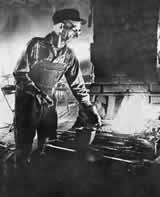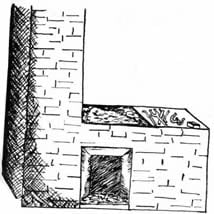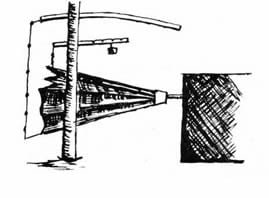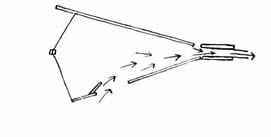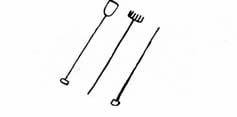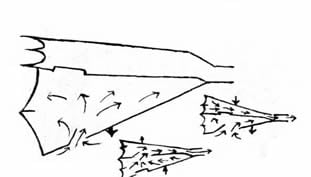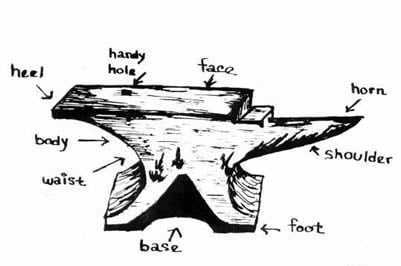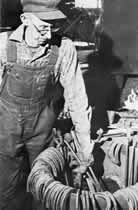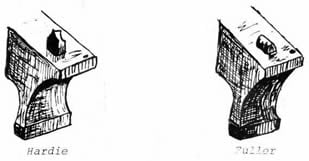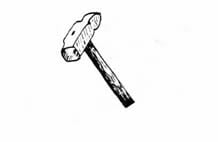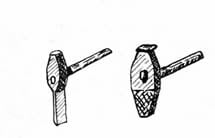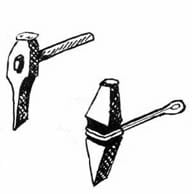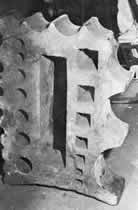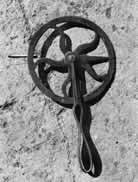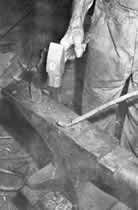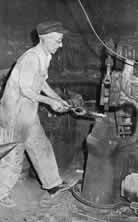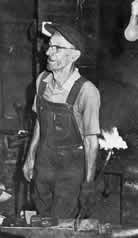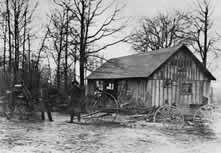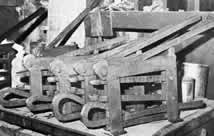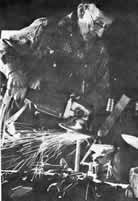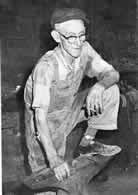by Rick Bishop
Photographs by Stephen Hough, Drawings by Nancy Honssinger
Under a spreading chestnut-tree
The village smithy stands;
The smith, a mighty man is he,
With large and sinewy hands;
And the muscles of his brawny arms
Are strong as iron bands.
His hair is crisp, and black, and long,
His face is like the tan;
His brow is wet with honest sweat,
He earns what e'er he can,
And looks the whole world in the face,
For he owes not any man.
Week in, week out, from morn till night,
You can hear his bellows blow;
You can hear him swing his heavy sledge
With measured beat and slow,
Like a sexton ringing the village bell,
When the evening sun is low.
--Longfellow
The beginning of this famous poem illustrates for the reader a highly honorable man who practices a somewhat glamorous trade. During the middle 1800's when Longfellow wrote this poem, the blacksmith was an esteemed man and his trade was indeed respected.
Fred Manes has been blacksmithing all his life as his father and grandfather before him Today, however, upon hearing the word 'blacksmith,' most people probably picture an obsolete man, rugged and muscular, with black soot from head to foot, sweating over a hot fire. Though this seems to us an undesireable trade, somehow most of us still have a hidden respect and admiration for a man who makes a living at this difficult and dirty task.
Many people nowadays would never believe that blacksmiths like Longfellow's still exist, but there are a few. The reason there are not more is not so much because blacksmithing is an intolerable trade, but because one man working with his hands is no match for mass production. Possibly another factor is that men do not want to dirty their hands anymore.
The blacksmith is of a special breed--- not necessarily a breed of strong and rugged individuals who like to sweat and strain, but men with special uncommon talents to create with metal. A good blacksmith has to be intelligent, but not necessarily educated, for hellions by doing, usually through apprenticeship. Often blacksmiths are sons of blacksmiths.
From the time America began as a group of colonies until the late 1800's, the blacksmith was considered one of the most essential, if not the most essential member in the community and was heavily depended upon by almost everyone. Probably the most important duty of any village blacksmith was to supply the tools on which civilization depended--tools for building, for crafts, farming and for war. Blacksmiths were a necessity in keeping horses and mules shod and in the building of ships and wagons, the chief means of transportation in early America. He also kept anything made of metal in repair and functioning.
The housewife depended as much on the blacksmith as anyone for kitchen wares and cooking utensils made of metal, such as forks, spoons, ladles and strainers.
To understand the importance of the blacksmith before mass production put him out of business, one must bear in mind that the essentials for building any structure or piece of equipment could not be acquired at the local hardware store. These essentials, including hinges, door latches and window latches, to name a few, were handmade by the village blacksmith.
Blacksmithing requires imagination and visualization. As is true of any art, there are those who are exceptionally skillful, and there are those who are not. In blacksmithing, a man who tried to make a living at it would usually fail unless he was good. Those who were not good were called "botchers" and had to go way back in the hills to get any work.
Most of the few blacksmiths who still practice today do it as a hobby or as a sideline, depending upon some other source for the large part of their incomes. However there is at least one man today who still depends on blacksmithing as his source of income. That man is Fred Manes, and he has practiced his art for over sixty years on the same corner of the main street of Richland, Missouri, where his father operated before he did.
A blacksmith shop is an interesting and intriguing place. One of the first things I noticed when our staff visited Fred Manes' shop was the activity, the excitement of the blazing fire and flying sparks, and the refreshing atmosphere of seeming disarray which welcomed the passerby to stop a moment. For this reason loafers are probably as traditional in a blacksmith shop as is the anvil, and no wonder. I later learned that the same men came to the shop every day, just passing the time while Fred worked at the forge. Fred does not mind having the loafers around; in fact, he says he would work himself to death if there wasn't anyone around to stop and talk to. Good company and friendliness prevail in the blacksmith shop.
Children of all ages drop in the shop from time to time and Fred enjoys having them around as well. To a child there is probably nothing more intriguing than a blacksmith shop. What could be more fascinating to a young person's eyes than the smoke rolling from the fire, the red hot metal shaping under the hammer, turning from red to iron blue, and the hot metal sizzling when thrust in water? Just as fascinating are the interesting junk and old tools hanging on the walls. For the little girls, Fred shapes rings out of spoon handles. "You make them a ring, you've about won them over," he says.
Fred's shop is probably typical of any old-time blacksmith shop--the only real difference being that Fred has some electrically powered tools not available to earlier blacksmiths. One side of his shop is scattered with barstock and scrap metal. In the middle of the wall is the forge with the anvil standing about three or four feet in front of it. The bellows is built into the forge. On the opposite side of the building from the forge is a work bench where Fred does various things, such as fitting ax heads and cutting wooden handles to fit. Under this bench, Fred keeps his supply of Various kinds of handles for axes and hoes. The area between the forge and this work bench is usually occupied by the loafers sitting in chairs Fred keeps around the shop for them.
As you walk into his shop in the left corner you will see a cluttered desk where Fred keeps his records. The desk bought from a butcher is over a hundred years old.
The walls of the shop, blackened over the years from the smoke, are used for hanging various tools. The floor is heavily cluttered with all sorts of metal ranging from scrap horseshoes to barstock. Fred leaves everything on the floor so he will know where to look to find it. The floor is anything but clean and is probably not swept very often, for cleanliness is one thing a blacksmith does not have to worry about in the shop. The shop is continually filled with smoke from the forge and this is probably why the double doors on three walls are kept open most of the time.
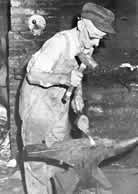
The blacksmith like all craftsmen needs tools, but he has the unique ability to make his own. For every blacksmith there are probably a few tools like no other tools anywhere else in the world--the smith's own tools for his individual methods. But there are some basic essential tools found in every shop; among these are the forge and bellows, anvil and slack tub and hand tools like the hardie, fuller, hammer and tongs, punch and chisel.
The forge, no matter what size, as it varies, is the all important fire container to heat the metal to the right temperature for working with it. (see illus. #1) Forges are usually at least thirty inches high and about two to three feet square. The hearth also varies in size but is usually proportioned to the overall dimension. It is made of brick and can cause metal to reach white hot temperatures in a few minutes. Directly over the forge is a hood connected to a chimney which carries the smoke out. The most common fuel is coal. Fred estimates that he uses anywhere from seventy-five to a hundred pounds of coal each day. Every forge is accompanied by an air pipe connected to a bellows which keeps a steady flow of air blowing up through the fire to keep it burning and also to make the fire hotter. (see illus. #2)
There are various types of bellows, but they all work on the same principle. If you have ever seen a fireplace bellows, you have seen a miniature form of the blacksmith's bellows. The hand powered bellows were made of wood and leather with valves, pipes and levers.
The simpler single chambered bellows was made of two boards of the same shape, usually tear-drop, attached to each other with leather to make an airtight chamber. When the boards were separated, they created a vacuum which filled the chamber with air through a hole located on one of the boards. A valve in this hole opening automatically from the pull of the vacuum allowed the air to enter. Pressing the boards together created a pressure which closed the air valve and forced the air out of the chamber through a blow pipe where the boards were hinged together. This pipe carried the air under the fire and blew it up through the fire. The single chambered bellows has not been used for many years since a better bellows was invented which had the advantage of a steady flow of air. (see illus. #3a)
Illus.#1 - The forge is the all-important fire container.
Illus. #2 - A hand-operated bellows.
Illus. #3a - The single chambered bellows.
Illus. #4 - Hand tools used with the forge.
The more efficient bellows was the double chambered bellows which was made of two airtight chambers instead of one. (see illus. #3b) This bellows created a steady flow of air whereas the single chamber produced air in spurts, keeping a hotter and steadier temperature. The double chambered bellows was made of three tear-drop shaped boards about three or four feet long. In addition to the top board and the bottom board, there was a middle board which separated the two chambers. The leather was tacked around these boards to make two airtight chambers. The lower and middle boards each had air valves. The bellows was mounted on uprights, a chain attached to the bottom board and to a lever located above the bellows. The upper board rested on top of the middle board and the lower board fell by its own weight. The lever was used to raise the lower board, forcing air through the air valve in the middle board, inflating the upper chamber and sending air through the blow pipe to the hearth. The lever was released, the lower board again fell and the lower chamber inflated with air. At the same time the upper board fell, forcing the middle valve shut and blowing more air through the pipe. A weight was usually placed on the top board to increase pressure. Pumping the lever at a steady pace maintained a constant flow of air.
Fred Manes no longer uses a bellows, for an electric air pump supplies his air. He simply turns a lever near his hearth when he needs more air. Before electric air pumps were available, blacksmiths had to have assistants to pump the bellows while working at the forge. Without an assistant he would have to pump until the fire was hot enough to work with and then work until it was no longer hot enough.
On the top of Fred's forge are scattered hand tools of various sorts, such as tongs and pokers, which are used in conjunction with the forge. (see illus. #4) Each blacksmith probably has a different individual system of placing all the different tools where he can get to them easily when he needs them.
An anvil has probably been associated with blacksmith shops ever since black-smithing has been in existence. It is a basic tool of the blacksmith and is located near the forge. Fred simply pivots from his forge to reach his anvil. The typical size of the anvil used by most smiths ranges from one hundred to two or three hundred pounds. Care must be taken not to chip the anvil, for it is not indestructible in spite of its great weight. The parts of the anvil are the body, face, table, horn, heel, base and feet. (see illus. # 5)
A cross-section of a log bigger in diameter than the base of the anvil is used to support Fred's anvil. The log raises the anvil to a comfortable working level several inches below the waist. Tools are hung by nails on this log for quick access. This log has a hollow place in it where he puts lard. Fred inserts the point of the punch through a hole in the log, covering the point with grease to make punching easier.
Illus. #3b - The double chambered bellows.
Illus. #5 - The anvil and its parts.
Another of the basic necessities in a blacksmith shop is the slack tub located near the forge and anvil. This is nothing but a large tub or barrel filled with water. The slack tub is used to cool the iron rapidly so that it may be handled, but more important, dipping very hot metal into the cool water tempers it, or makes it harder and stronger. In Fred's shop, the rim of the barrel he uses for a slack tub is used for storing horseshoes.
There is an abundance of hand tools that play an important part in the art of blacksmithing.
The three basic tools used with the forge are the rake, shovel and poker. (see illus. #4) The rake is used to smooth the coals over the fire. The small shovel is used to arrange the coal and to pack it. The poker is a blunt pointed rod about one-fourth of an inch in diameter and about three feet long. Fred explained, "I use it to keep my fire going and to dig down if there's a clinker gets in the bottom of my forge. You dig it out cause that's where your sulphur out of your coal gathers in those clinkers that get in the bottom of your fire. A piece of sulphur as big as a pin head will keep a place as big as your hand from welding. We don't get good coal now like we used to. We just have to take whatever we can get. The real blacksmith coal is mined in the far east. It is a deep mine coal--no sulphur in it. You can work all day and maybe get a clinker as big as your hand in the bottom of your forge."
The next group of tools is used with the anvil. Most of the anvil tools are similar in that they have a square shank design which fits snugly into the hardie hole located on the face of the heel of the anvil. (see illus. #5)
Probably the most important anvil too] is the hardie from which the name for the hardie hole was derived. The hardie is a chisel used for cutting barstock. (see illus. #6) Barstock is long strips or bars of metal about ten to fifteen feet in length used for many things including making horseshoes. There are two different kinds of hardies, as is true with many of the anvil tools. There are those made for working with the metal while it is hot and those for working with the metal when it is cold.
Another anvil tool which closely resembles the hardie is the fuller which differs from the hardie in that it has a rounded edge instead of a sharp one. (see illus. #6) The fuller is used for making a piece of metal thinner or flattening it out. Metal is pounded against the fuller and then smoothed with a hammer.
The slack tub is used to cool and temper the hot metal.
Illus. #6 The hardie and the fuller are tools which are placed in the hardie hole of the anvil.
The hammer is one of the most frequently used tools in the blacksmith shop, and in most shops there are many different sizes and shapes of hammers, usually made of steel and iron. The most commonly used is the four pound cross-peen hammer. (see illus. #7) A four pound hammer, according to Fred, is the most practical, being light enough for the smith to work with it all day, and heavy enough to do the job. There are many other types of hammers used, most of them having a specific use, such as the chisel-maker and file-maker hammers. Most hammers are hard faced, but some are soft faced for doing repair work where the hard faced hammer would mar the surface.
Illus. #7 - The cross-peen hammer
The blacksmith tongs vaguely resemble a big pair of pliers. They are used to hold the hot metal while working with it at the forge and anvil. They work on the same principle as do household pliers and are usually about two feet long. The jaws form a circle with the lips holding the metal. There are many different kinds of tongs, just as with any anvil tool. Straight lipped tongs (see illus. # 8) are the most commonly used, but for various shapes of metal there are tongs with various types of lips. Fred makes his own tongs. "I never buy a pair of tongs. I forged out every pair."
Illus. #8 - Tongs come in various shapes and sizes
Punches and chisels are simple tools, but nevertheless very important to black-smithing. (see illus. # 9) Punches were formerly used instead of drills before electrical drills became available. Even today they are important for other uses. Punching is done by holding the punch of the desired size with the pointed end against the hot metal. The punch is driven through the hot metal with a hammer leaving a perfectly round hole.
Illus. #9 - Punches (above) and Chisels (below). Punches and chisels are simple tools, but nevertheless very important to blacksmithing.
Some punches are equipped with handles for safety. The ones that do not have handles are usually about two feet long, for punching is almost always done when the metal is hot. The handles are crude, because they do not have to be shaped to hold the punch. Punch sizes range from one-fourth inch to one and one-half inches.
There are two kinds of hardie chisels, the hot and the cold chisel.
Cold chisels have short shanks and the hot chisels, since they are used with hot metal, have long shanks or handles like the punches. The width of chisels ranges from one-half inch to two inches.
Fred still has in his shop some tools he rarely uses anymore which used to be essential. Some of these which he explained are the swages, traveler and mandrel.
The swages were made in almost every imaginable shape and size. Swages were used for such things as making bolts, tools, various shapes of rods and many other items. A swage is a mold, more or less. (see illus. #10) "That was used when those old steam engines had to have bolts--you couldn't buy them. We could make all the bolts they used. All these little places here had a hammer the same that matched all these and you put whatever you're making down in that and take a sledge hammer and drive it in here for the square shoulders next to the head. You make your bolt the size you want it. It was a wonderful tool in its day and I still use it, but it's kinda going out." Swage blocks are usually about three inches thick and about twenty inches square. Today there is little, if any use for swage blocks because bolts and tools are abundant in hardware stores.
The traveler is a six inch iron wheel equipped with a handle. (see illus. #11)
Illus. #10 - The swage block was once an essential tool used to make bolts and nuts of any size needed.
Illus. #11 - (above) The traveler used to be the only way to measure the diameter of such things as wagon wheels. (below) Shaping hot metal under the hammer
The wheel turns freely. A traveler can be used to measure the diameter of something. "You measure the outside of a wagon wheel and the inside of a tire with that. That's the only way you used to be able to measure it. There's your starting place on this marker. You go around the wheel with it and when you get back to where you started you move this to mark each round. This would be the exact measurement of the wheel. But now days that's all over. That used to be about all we done."
It used to be common to see an iron cast cone standing about three feet tall as it rested on its base on the floor with the point of the cone up. "That also was used back in the days of building wagons," Fred explained. "This is a thing we used to use to bend the wagon tire with, curl it around, weld it up and put it on. That's called a mandrel. See how it tapers? That was made to make a hub band--a band that went around the hub of a wagon. We'd drop them down over that and cure them up." Fred has little use for this tool anymore. (see illus. #12)
Illus. #12 - Today there is little use for a mandrel, once a common sight in blacksmith shops. They were used to shape round objects such as hub bands.
The trip hammer seemed to stand out among all the other tools in Fred's shop perhaps because it was the loudest thing in the shop. (see photo below) This piece of equipment used to be powered by water, but now is electrical. The trip hammer consists of a large hammer head that pounds rapidly against a plate. It is operated by a foot pedal and is used for heavy metal work which required a lot of hard pounding.
The trip hammer is a modern machine which used to be powered by water.
Fred pausing to talk with a customer
The tools I have discussed are just a few of the many tools used by the blacksmith. Each blacksmith has in his shop many tools which only he knows how to use. The basic tools which were described are found in almost any shop, except for the trip hammer which was used only in shops that had falling water near to furnish the power.
[36]
The blacksmith may not be a match for mass production, but mass production may not be a match for the quality and durability of the blacksmith's work. A good example of this is welding. "I don't think there ever was a weld that would equal a forge weld," Fred said. "It's the best weld there is." The forge weld is a process which may take more time than welding with modern welders, but to hold two pieces of steel together, it is the best bet. The process is relatively simple. In order to weld two rods together, both rods are stuck into the forge, burying one end of each rod under the coals until red hot. The hot ends are dipped in sand to make the weld hold. The two hot ends are then pounded together with a hammer on the anvil until the metal is too cool to work with and then it is put back in the fire. This is repeated until the two are fused together making the joint as strong as the rest of the rod.
When we asked Fred if any young man ever came in to work with him, he replied, "No, it's too hard work. Once in a while some young fella comes in and he'll work at the electric welder. I try to get him to go over there to the forge, but that sweat over there makes him sick...he can't stand the smell of sweat. They won't stay with it. I ought to have two young men in here to do all the work."
"What will happen to your shop when you quit?"
"It'll close down. That will be the end of it."
A typical blacksmith shop at Oakland, Missouri in 1910
Fred designs black walnut crackers.
Blacksmithing is indeed becoming a lost art. Perhaps in a few years there will be no blacksmiths at all, but in their time the village could hardly function without one. Today, however, it is different. Most of the work Fred does is making and shaping horseshoes, making his self-designed black walnut crackers, sharpening picks and hoes, welding and general repair work of metal farm tools. He is always busy and has more work than he can do, but his importance as an indispensable man is gone as well as the glamor of the village smithy as immortalized by Longfellow.
Fred comes from a long line of blacksmiths. His father was a smith and his grandfather before that. He probably knows as much about blacksmithing as any man in the country, as he has been practicing it continually for over sixty years. At the age of eighty-one Fred has no intention of retiring--yet. He often tells his loafers that he is going to keep blacksmithing until he is a hundred years old, then go to farming for a year. If he doesn't like farming, he will come back to the shop.
"He's the best I've seen, and I've been all over the world," one customer told me.
(Above) Modern machinery saves a lot of elbow grease. (Below) Blacksmiths have to take breaks frequently.
Toiling,--rejoicing,--sorrowing,
Onward through life he goes;
Each morning sees some task begin,
Each evening sees it close;
Something attempted, something done,
Has earned a night's repose.
Thanks, thanks to thee, my worthy friend,
For the lesson thou hast taught!
Thus at the flaming forge of life
Our fortunes must be wrought;
Thus on its sounding anvil shaped
Each burning deed and thought!"
--Henry Wadsworth Longfellow
